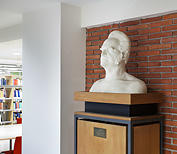Bjørnstjerne Bjørnson
Bjørnstjerne Bjørnson (1832-1910) is considered along with Henrik Ibsen, Jonas Lie and Alexander Kielland as one of “the great four”, the leading poets in late nineteenth century literature in Norway. Among Bjørnson’s most famous texts are the tale of En glad Gut (A Happy Boy) and the Norwegian national anthem Ja, vi elsker dette landet. The marble bust in the HF library is made by Gustav Vigeland.

Main content
As much as for his poems, stories and plays, Bjørnson was known for his personality and his political involvement. He was very concerned with social issues and the development of the nation of Norway. International peace work was as important a cause to him, and he sat in the Norwegian Nobel Committee from 1901 to 1906. Bjørnson was awarded the Nobel Prize in Literature in 1903.
The marble bust portrays him with a raised chin, his eyes gazing upward under the protruding brows. The corners of his mouth are turned down, he seems determined, not angry. This, along with a slightly hooked nose, gives him a noble, eagle-like look. The nude shoulders are held back, the whole figure is dignified, strong. Bjørnson is presented as a man of action, stunning and vibrant. Gustav Vigeland made the bust in Paris in 1901, and it is considered the start of his portrait period.
Adolf Gustav Vigeland (1869-1943) is one of the most famous Norwegian sculptors. He had a large production, and employed a number of sculptors to carve sculptures from his models. The Vigeland Park in Oslo is the largest sculpture park in the world created by a single sculptor, and the sculptures Monolitten and Sinnataggen are among the most famous Norwegian artworks. Vigeland also designed the statue of Bjørnson standing in front of Den Nationale Scene in Bergen. Vigeland was appointed Officer of the Order of St. Olav in 1901, and received the Grand Cross of the Order in 1929.
NORA SØRENSEN VAAGE
